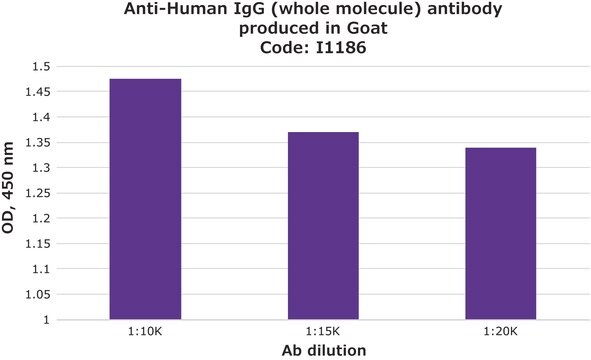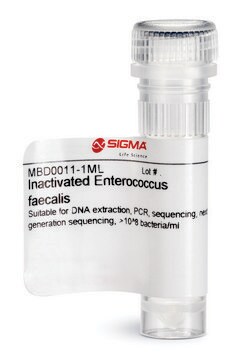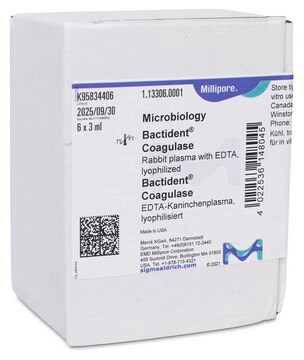SAB4200883
Anti-Staphylococcus aureus LTA antibody, Mouse monoclonal
clone LT-43, purified from hybridoma cell culture
Sinonimo/i:
Staphylococcus aureus
Autenticatiper visualizzare i prezzi riservati alla tua organizzazione & contrattuali
About This Item
Codice UNSPSC:
12352203
NACRES:
NA.41
Prodotti consigliati
Forma dell’anticorpo
purified from hybridoma cell culture
Livello qualitativo
Clone
LT-43
Forma fisica
liquid
Reattività contro le specie
Staphylococcus aureus
Concentrazione
~1 mg/mL
Isotipo
IgM
Condizioni di spedizione
dry ice
Temperatura di conservazione
−20°C
modifica post-traduzionali bersaglio
unmodified
Descrizione generale
Staphylococcus aureus is a Gram-positive bacterium, that causes disease in the human population including food poisoning and toxic shock syndrome.1 S. aureus expresses several secreted virulence factors, such as various enzymes, cytotoxins, exotoxins, and exfoliative toxins.1 Exotoxins include more than 20 serologically classified staphylococcal enterotoxins (SEs). The best characterized are the SEs A, B through V, and toxic shock syndrome toxin-1 (TSST-1). These enterotoxins are similar in activity, sequence, structure, and molecular mass (25-30 kDa).1-3
Specificità
Monoclonal Anti- Staphylococcus aureus lipoteichoic acid (LTA) antibody specifically recognizes LTA of Staphylococcus aureus and has no cross reactivity with Bacillus subtilis LTA and Enterococcus hirae LTA.
Applicazioni
The antibody may be used in various immunochemical techniques including Immunoblotting and ELISA.
Azioni biochim/fisiol
SEA and SEB are known as superantigens due to their ability to bind class II MHC molecules on antigen presenting cells. This binding stimulates extensive T-cell activation followed by massive cytokine release leading to an acute toxic shock.1-4 SEB is also classified as a category B select agent and is important toxicant in biodefense research.5-9SE proteins have a significant resistance to heat and acid, and are also resistant to gastrointestinal proteases including pepsin, trypsin, rennin, and papain. Thus, inactivating the S. aureus bacteria may not be sufficient to eliminate the risk of its superantigens from causing food poisoning.1 SEB contamination can be caused by both its ingestion (resulting with food poisoning) or by inhalation (resulting with respiratory symptoms of cough and dyspnea), therefore SEB detection is a major challenge in the food industry.1,3,5-10
Stato fisico
Supplied as a solution in 0.01 M phosphate buffered saline pH 7.4, containing 15 mM sodium azide as a preservative.
Stoccaggio e stabilità
For continuous use, store at 2-8°C for up to one month. For extended storage, freeze in working aliquots. Repeated freezing and thawing is not recommended. If slight turbidity occurs upon prolonged storage, clarify the solution by centrifugation before use. Working dilution samples should be discarded if not used within 12 hours. Protect from prolonged exposure to light.
Esclusione di responsabilità
This product is for R&D use only, not for drug, household, or other uses. Please consult the Material Safety Data Sheet for information regarding hazards and safe handling practices.
Codice della classe di stoccaggio
12 - Non Combustible Liquids
Classe di pericolosità dell'acqua (WGK)
WGK 1
Certificati d'analisi (COA)
Cerca il Certificati d'analisi (COA) digitando il numero di lotto/batch corrispondente. I numeri di lotto o di batch sono stampati sull'etichetta dei prodotti dopo la parola ‘Lotto’ o ‘Batch’.
Possiedi già questo prodotto?
I documenti relativi ai prodotti acquistati recentemente sono disponibili nell’Archivio dei documenti.
Il team dei nostri ricercatori vanta grande esperienza in tutte le aree della ricerca quali Life Science, scienza dei materiali, sintesi chimica, cromatografia, discipline analitiche, ecc..
Contatta l'Assistenza Tecnica.






